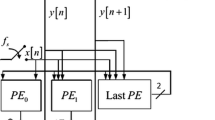Abstract
The occurrence of soft-faults in digital circuits due to single event upsets (SEU) caused by particle hits has been reported in many works, and it has been claimed that, as the transistor dimensions shrink, multiple and simultaneous faults will be a common scenario in future technologies. Many techniques have been proposed to cope with these kinds of faults, most of them based on hardware or software redundancy. In this work, we present a new paradigm, which is based on signal redundancy, that is, the signal to be processed will contain a certain amount of redundancy, in such a way that, even under the occurrence of multiple faults, the final results will sustain a good resolution for some applications. A DSP microprocessor that uses the technique was prototyped, and some results are presented and compared to typical n-bits binary coded DSP microprocessor architecture, showing the advantages of using the proposed approach.
Similar content being viewed by others
References
F.L. Yang and R.A. Saleh, “Simulation and Analysis of Transient Faults in Digital Circuits,” IEEE J. Solid-state Circuits, vol. 27, no. 3, pp. 258–264, March 1992.
G.C. Messenger, “A Summary Review of Displacement Damage from High-energy Radiation in Silicon Semiconductors and Semiconductor Devices,” IEEE Trans. Nucl. Sci., vol. 39, no. 3, pp. 468–473, June 1992.
E.C. Smith and M. Shoga, “Double Upsets from Glancing Collisions: A Simple Model Verified with Flight Data,” IEEE Trans. Nucl. Sci., vol. 39, pp. 1859–1864, 1992.
P.K. Chande, A.K. Ramani, and P.C. Sharma, “Modular TMR Multiprocessor System,” IEEE Trans. Ind. Electron., vol. 36, no. 1, Feb. 1989.
M. Rebaudengo and M.S. Reorda, “Evaluating cost and effectiveness of software redundancy techniques for hardware errors detection,” Digest of Fast Abstracts: FTCS-28, The 28th Annual International Symposium on Fault-tolerant Computing, June 23–25, Munich (Germany), pp. 88–89.
S.R. Norsworthy, R. Schreier, G.C. Temes, Delta–sigma Data Converters: Theory, Design and Simulation, New York: IEEE Press, 1997, 476 p.
E. Schüler and L. Carro, “Increasing Fault Tolerance to Multiple Upsets Using Digital Sigma–Delta Modulators,” 11th International On-line Testing Symposium (IOLTS’05). France, 2005. June 27–29, 2005.
E. Schüler and L. Carro, “Reliable Digital Circuits Design using Sigma–delta Modulated Signals,” 20th IEEE International Symposium on Defect and Fault Tolerance in VLSI Systems, 2005 (DFT’05), 03–05 Oct. 2005, USA.
P. Basedau and H. Qiuting, “A post processing method for reducing substrate coupling in mixed-signal integrated circuits,” Symposium on VLSI Circuits, Kyoto, 8–10 June, pp. 41–42, 1995.
IBM. “SOI Technology: IBM’s Next Advance in Chip Design”. Last access: Oct. 2005. http://www-03.ibm.com/chips/about/technology/technologies/soi/.
H. Weaver, et al., “An SEU Tolerant Memory Cell Derived from Fundamental Studies of SEU Mechanisms in SRAM,” IEEE Trans. Nucl. Sci., vol. 34, no. 6, Dec. 1987.
J.M. Rabaey, Digital Integrated Circuits—A Design Perspective, Upper Saddle River, NJ: Prentice Hall, 1996, 702 p.
E.F. Cota, et al., “Synthesis of an 8051-like Microcontroller Tolerant to Transient Faults,” J. Electron. Testing-Theory App., (Dordrecht) vol. 17, no. 2, pp. 149–162, 2001.
J.S. Plank, “A Tutorial on Reed–Solomon Coding for Fault-tolerance in RAID-like Systems,” Department of Computer Science, University of Tennessee.
K.H. Huang and J.A. Abraham, “Algorithm-Based Fault Tolerance for Matrix Operations,” IEEE Trans. Comput., vol. 33, pp. 518–528, 1984.
S.K. Gupta, M.A. Breuer, and T.M. Mak, “Defect and Error Tolerance in the Presence of Massive Numbers of Defects,” IEEE Des. Test Comput., vol. 21, no. 3, pp. 216–227, May 2004.
B.W. Johnson, “Fault Tolerance,” The Electrical Engineering Handbook, R.C. Dorf, ed., Boca Raton, FL: CRC Press, 1993, p. 2020.
K. Nepal, R.I. Bahar, J. Mundy, W.R. Patterson, A. Zaslavsky, “Designing Logic Circuits for Probabilistic Computation in the Presence of Noise,” Proceedings of 42nd IEEE Design and Automation Conference (DAC2005), June 13–17, 2005, Anaheim, CA.
L. Anghel, D. Alexandrescu, and M. Nicolaidis, “Evaluation of soft error tolerance technique based on time and/or space redundancy,” Proceedings of 13rd IEEE Symposium on Integrated Circuits and Systems Design (ICSD 2000), Manaus, Brazil, September 2000, pp. 237–242.
C.L Janer, J.M. Quero, J.G. Ortega, and L.G. Franquelo, “Fully Parallel Stochastic Computation Architecture,” IEEE Trans. Signal Process., vol. 44, no. 8, pp. 2110–2117, IEEE Computer Society, New York, 1996.
C. Lisbôa and L. Carro, “Arithmetic Operators Robust to Multiple Simultaneous Upsets,” Proceedings of the 19th IEEE International Symposium on Defect and Fault Tolerance in VLSI Systems—DFT 2004, pp. 289–297, ISBN0-7695-2241-6. IEEE Computer Society, New York, October 2004.
J.C. Candy and G.C. Temes, Over Sampling Delta–sigma Data Converters: Theory, Design, and Simulation, New York: IEEE Press, c1992. vol. xii, no. 499 p. il.
G.W. Robert and A.K. Lu, Analog Signal Generation for Built-in-self-test of Mixed-signal Integrated Circuits, Boston, MA: Kluwer, 1995, p122.
F. Maloberti, “Non Conventional Signal Processing by the Use of Sigma Delta Technique: A Tutorial Introduction,” Proc. IEEE Int. Symp. Circuits Syst. (ISCAS), vol. 6, pp. 2645–2648, May 1992.
V. da Fonte Dias, “Sigma–Delta Signal Processing,” IEEE Int. Symp. Circuits Syst. ISCAS’94, vol. 5, pp. 421–424, 30 May–2 June 1994.
B.E. Boser and B.A. Wooley, “The Design of Sigma–delta Modulation Analog-to-Digital Converters,” IEEE J. Solid-state Circuits, vol. 23, no. 6, Dec. 1988.
E. Schüler, D.S. Farenzena, L. Carro, “Evaluating Sigma–Delta modulated signals to develop fault-tolerant circuits,” Proc. of 11th IEEE European Test Symposium, 2006. ETS’O6, Southampton, UK, 21–25 May, 2006.
Available at http://www.analog.com Last access: Jan. 2006.
J.M.A. Tanskanen, “Coefficient Quantization Error Free Fixed-point IIR Polynomial Predictor Design,” Proc. 2000 IEEE Nordic Signal Processing Symposium, Kolmarden, Sweden, June 2000, pp. 219–222.
Author information
Authors and Affiliations
Corresponding author
Additional information
Editor: M. Tehranipoor
Special issue on Test, Defect Tolerance and Reliability of Nanoscale Devices
Rights and permissions
About this article
Cite this article
Schüler, E., Erigson, M.I. & Carro, L. Functionally Fault-tolerant DSP Microprocessor using Sigma–delta Modulated Signals. J Electron Test 23, 275–292 (2007). https://doi.org/10.1007/s10836-007-0760-z
Received:
Revised:
Published:
Issue Date:
DOI: https://doi.org/10.1007/s10836-007-0760-z




